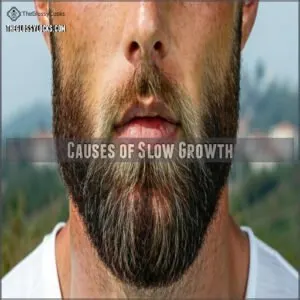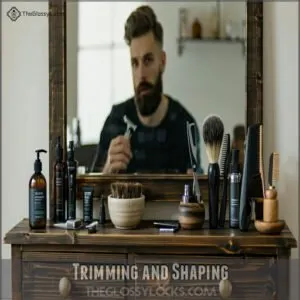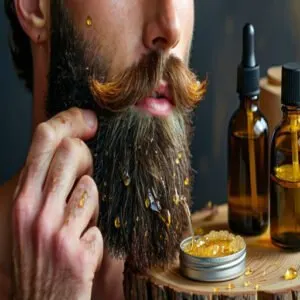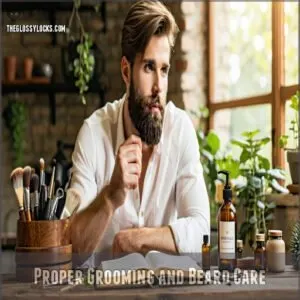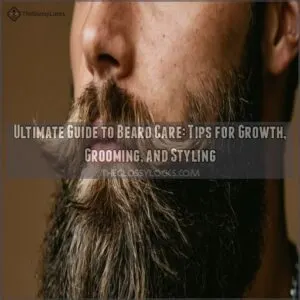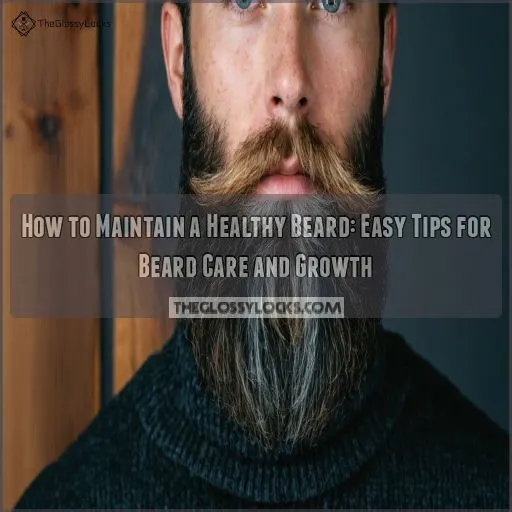This site is supported by our readers. We may earn a commission, at no cost to you, if you purchase through links.

Your beard care for slow growth starts with understanding what’s in your DNA’s playbook: genetics and hormones are the key players.
You’ll want to fuel your facial forest with lean proteins, zinc-rich foods, and healthy fats while keeping your beard game strong with gentle washing, conditioning, and regular brushing.
Think of your beard as a bonsai tree – it needs patience, proper nutrition, and the right care routine.
There’s more to mastering the art of beard growth than meets the eye, including some game-changing techniques that could transform your facial hair journey.
Table Of Contents
- Key Takeaways
- Causes of Slow Growth
- Beard Care Essentials
- Stimulating Beard Growth
- Addressing Patchy Growth
- Maintaining Healthy Growth
- Frequently Asked Questions (FAQs)
- How do I overcome slow beard growth?
- Does castor oil help with the growth of a beard?
- Are You concerned about slow beard growth?
- How do I keep my beard healthy?
- What should you consider during the first week of beard growth?
- How can a balanced diet help a beard grow?
- How do you fix a slow beard growth?
- What is the 3 month beard rule?
- What is the rule 5 for beards?
- Will my beard fill in after 25?
- Conclusion
Key Takeaways
- Genetics, hormones, age, and lifestyle choices are the main factors influencing your beard growth.
- A healthy diet with lean protein, whole grains, zinc-rich foods, and vitamins supports beard care.
- Beard care essentials include gentle washing, conditioning, trimming, brushing, and using beard oil or balm.
- To stimulate beard growth, consider massaging and exfoliating your face, using growth stimulants, maintaining healthy skin, and reducing stress and improving sleep.
Causes of Slow Growth
There are a bunch of reasons why your beard growth might be lagging.
The main culprits are usually genetics, hormones, age, and lifestyle choices.
Sometimes, underlying medical conditions can also be the cause, so it’s important to rule those out first.
Genetics and Hormones
Genetics play a huge part in the lottery of facial hair growth.
Some guys hit the jackpot with thick, fast-growing beards, while others are left scratching their heads (or sparse stubble) wondering why theirs is a slow burner.
It’s all down to testosterone—the hormone that fuels beard growth.
Higher levels generally mean thicker beards, but it’s a fine balance as too much or too little can mess with your growth rate.
Ethnic background also influences how your beard rolls out.
Understanding facial hair thickness is key to addressing slow growth and optimizing beard care.
Age and Puberty
While genetics set the foundation for beard growth, puberty and hormone balance play a huge role in determining those first fuzzy whispers.
It’s like a choir warming up before the main event—those early puberty stages are growth patterns gearing up for the big show.
Here’s how age and puberty impact that journey:
- Puberty Stages: Those hormones raging during puberty kickstart beard growth.
- Growth Patterns: As you move through the development phases of puberty, your beard also goes through growth spurts and patterns, finding its groove.
- Age Factors: The older you get, the more your beard growth reflects the journey.
It’s like a map, with each age marking a different stage of discovery.
Nutrition and Lifestyle
Puberty may have come and gone, but that doesn’t mean your diet and lifestyle can’t impact your beard growth.
A healthy diet with lean protein, whole grains, and foods rich in zinc and vitamins B, A, C, D, and E supports beard growth.
Think of it like this: your body needs fuel to grow that beard, and a well-rounded diet is the key to a fuller, healthier mane.
To achieve a healthy beard, practicing good beard maintenance techniques is vital for overall beard health.
| Beard Growth Diet | |
|---|---|
| 1 | Lean Protein |
| 2 | Whole Grains |
| 3 | Zinc-Rich Foods |
| 4 | Healthy Fats |
| 5 | Fruits & Veggies |
Underlying Medical Conditions
- Hormone Imbalance: Low testosterone levels can hinder beard growth. Talk to your doc if you suspect a hormone imbalance.
- Skin Disorders: Alopecia barbae and seborrheic dermatitis can affect the hair follicles, leading to patchy beards.
- Autoimmune Diseases: These can impact hormone levels and cause chronic inflammation, both detrimental to beard growth.
- Thyroid Issues: Thyroid problems can mess with testosterone levels, causing growth issues.
Beard Care Essentials
Mastering the fundamentals of beard care is essential for any guy wanting to enhance his facial fuzz.
We’ll guide you through the basics, from gentle washing and conditioning to the right way to trim and shape your beard, so you can keep your beard looking and feeling its best.
Gentle Washing and Conditioning
Wash your beard like you’re washing a baby: with gentle care and attention.
Aim for 2-3 times a week, using warm water and a dime-sized amount of beard shampoo.
Avoid scrubbing aggressively.
After washing, use a soft brush to apply a light coat of gentle conditioner.
Rinse thoroughly and dry gently.
This routine keeps your beard clean, soft, and healthy, promoting growth.
| Product Type | Recommended Usage |
|---|---|
| Beard Shampoo | 2-3 times a week |
| Gentle Conditioner | Light coat, rinse thoroughly |
Trimming and Shaping
Trimming shapes your beard, tames wild hairs, and defines your style.
It’s like giving your beard a mini-makeover.
Here’s how to trim without overdoing it:
- Focus on facial symmetry.
- Neckline shaping is key.
- Control those edges.
Trim along your jawline to sharpen angles and define your shape.
Keep it tidy with a clean, curved line from behind one ear to the other.
Trim your cheek line for a neater finish, creating a subtle angle for a natural look.
Using a beard trimmer tool can help achieve a more precise cut.
Keep it simple, and you’ll master the art of beard trimming and shaping.
Brushing and Combing
Brushing and combing are key steps in your beard care routine.
They help distribute natural oils, keeping your beard soft and manageable.
Go with the grain, using gentle strokes to avoid tugging at those hair follicles.
Choose a beard comb with wide teeth for longer beards, and a finer-toothed comb for shorter beards.
Opt for a beard brush with natural bristles—boar bristles are great for beard detangling.
Add these tools to your beard care arsenal, and you’ll be brushing (and stroking) those worries away.
Beard Oil and Balm
Beard oil and beard balm are your BFFs in the battle against slow beard growth.
These products work like a charm to nourish and hydrate your beard, giving it that healthy shine.
Beard oil, with its magical blend of natural oils, tames frizz and transforms your hair texture, making it softer and easier to manage.
Meanwhile, beard balm acts like a leave-in conditioner, locking in moisture and giving your beard a neat, polished look.
So, don’t skip out on these beard care essentials.
Understanding the benefits of a beard oil set is vital for making informed decisions about your beard care routine.
Stimulating Beard Growth
If you’re keen to speed up that sluggish beard growth, it’s time to get hands-on with some stimulating strategies.
This section will arm you with techniques like massaging, exfoliating, and using growth-enhancing products to awaken those dormant follicles and promote a fuller, healthier beard.
Massaging and Exfoliating
Exfoliating and massaging your face are easy ways to boost beard growth.
Here’s how:
- Facial Massage: Roll your beard area with a derma roller to boost circulation and relax the skin.
- Skin Exfoliation: Exfoliate 2–3 times a week.
- Gentle Scrubbing: Avoid harsh scrubbing.
Follow up with a gentle facial massage using your fingers, and use a gentle scrub to remove dead skin and unclog pores, going easy to prevent irritating your skin and damaging hair follicles.
These simple steps can help kickstart slow beard growth.
Using Growth Stimulants
If you’re keen on giving your beard a boost, there are a few beard growth stimulants worth considering.
Minoxidil, known by the brand name Rogaine, is an FDA-approved hair growth medication that might just do the trick. Although it’s not specifically approved for beards, it’s available over the counter and could be worth a shot.
Beard growth supplements, vitamins, and natural stimulants like peppermint oil are also options to explore. But remember, results may vary, and it’s always a good idea to chat with a healthcare pro before starting any new regimen.
Understanding beard growth supplements can help you make informed decisions about your beard care routine.
Maintaining Healthy Skin
Healthy beard, healthy life" isn’t just a catchy saying.
Your skin is the foundation for a lush beard, so keeping it in tip-top shape is essential.
Here’s the lowdown on maintaining great skin health:
- Skin Exfoliation: Slough off dead skin cells with a gentle exfoliator to prevent buildup and keep your pores happy.
- Facial Massage: Stimulate blood flow and relax those tense facial muscles with a soothing massage.
- Skin pH: Keep your skin’s pH balanced to maintain its natural protective barrier.
- Natural Moisturizers: Opt for natural moisturizers like aloe vera and coconut oil to nourish your skin and beard.
Reducing Stress and Improving Sleep
Stress and poor sleep can wreak havoc on your beard growth goals.
Here’s the lowdown on why these factors matter and how to keep them in check.
We’ve all heard the phrase "stress makes your hair fall out."
Well, the same goes for your beard.
High stress levels can disrupt your body’s natural growth cycle, leading to slower growth or even hair loss.
So, finding ways to chill is key.
To further enhance your beard growth, consider incorporating beard growth exercises into your daily routine.
| Mindful Relaxation Techniques | |
|---|---|
| 1 | Deep Breathing |
| 2 | Meditation |
| 3 | Yoga |
| 4 | Tai Chi |
Try out different calming techniques like deep breathing, meditation, or yoga to manage stress.
A good night’s rest is also essential, so focus on improving your sleep patterns.
Addressing Patchy Growth
If you’re dealing with patchy beard growth, don’t fret.
This section will empower you with insights to tackle this issue effectively.
We’ll explore practical steps, from identifying and addressing underlying causes to employing specific products and practices for a fuller, healthier beard.
Identifying and Treating Underlying Causes
If you’re facing beard growth problems, it’s time to play detective and identify the root causes.
Hormone levels and genetic factors play a huge role in how your beard grows.
Get a medical screening to check for nutrient deficiency or other issues.
Slow beard growth could be due to lifestyle choices or underlying medical conditions.
Beard care for slow growth starts with understanding these causes.
Talk to your doc about hormone testing and discuss any concerns about your health.
Then, make necessary lifestyle changes.
Using Minoxidil and Other Growth Products
Identifying the cause of your patchy beard is a big step, but now it’s time to explore solutions.
Beard growth products like minoxidil, a topical solution that improves blood flow to the hair follicle, can stimulate growth.
Clinical studies back this up, showing that consistent use can lead to results, although individual experiences may vary.
You can apply it as a serum or foam, but be sure to follow the instructions and moisturize afterward for best results.
Many men have found success with beard growth products that are specifically designed to address patchy areas and promote a fuller beard.
Proper Grooming and Beard Care
The key to taming that wild mane? A solid beard care routine.
First, trim your facial hair regularly – it keeps your beard looking sharp and prevents those split ends from creeping up.
Next, wash and condition your beard 2–3 times a week. But remember, less is more in the process of scrubbing.
Finally, brush that beauty! It’ll help distribute those natural oils and keep your beard healthy and happy.
Understanding beard growth methods is also essential for addressing patchy areas and promoting a fuller beard. You can learn more about solutions through this link: beard growth methods.
Promoting Healthy Hair Follicles
Looking into your patchy beard growth?
Your hair follicles need some TLC.
Start with a gentle scalp massage to boost nutrient uptake and blood flow.
Mix a drop of peppermint oil with your beard oil to wake up those sleeping follicles.
Track your growth cycles and stick to a consistent beard care routine.
For better hair thickness, keep your face moisturized and protected from harsh elements, which will help with hair follicles.
Maintaining Healthy Growth
You’ll need more than just beard oil to keep your facial hair growing strong and healthy – it’s all about giving your beard the complete care package through good nutrition, exercise, and proper grooming habits.
If you’ve been treating your beard like a neglected houseplant, it’s time to step up your game with a solid routine that’ll keep those follicles happy and thriving, which is part of a good nutrition plan.
Balanced Diet and Nutrition
A well-stocked plate is your beard’s best friend.
Your nutrient intake directly impacts how well your facial hair grows, so let’s talk meal planning that works.
Pack your diet with protein-rich foods like eggs and lean meats, while adding healthy snacks like nuts and berries for vitamin balance.
Include zinc-rich pumpkin seeds and citrus fruits – they’re natural beard growth foods that’ll give your follicles the fuel they need.
Regular Exercise and Stress Reduction
While fueling your body with the right nutrients matters, movement and mindfulness pack an extra punch for your beard growth journey.
Beyond boosting testosterone levels, regular exercise and stress management create the perfect environment for your facial hair to thrive.
Here’s how to optimize your fitness routines for better beard growth:
- Hit strength training 3x weekly to naturally boost testosterone
- Mix in 20-30 minutes of cardio to improve blood circulation
- Practice stress-busting activities like yoga or meditation
- Schedule recovery days to prevent cortisol spikes
- Track your beard growth cycle alongside your workout progress
Getting Enough Sleep and Staying Hydrated
Beyond your workout routine, your beard’s health depends on sleep patterns and hydration.
Those restful nights boost testosterone levels, supporting healthy beard growth.
Morning routines should include drinking water – aim for 8 glasses daily to keep those follicles happy.
If you’re noticing slow beard growth, track your water intake and sleep schedule.
Your beard thrives when you’re well-rested and hydrated.
Avoiding Damaging Beard Care Habits
Now that you’ve mastered the sleep and hydration game, let’s tackle those sneaky habits that might be sabotaging your beard game.
Your daily routine could be causing beard breakage without you even knowing it.
Here are the beard-busting habits you’ll want to ditch:
- Cranking up that beard straightener’s heat (your hair follicles aren’t fans of excessive heat)
- Over-washing strips those natural oils (stick to 2-3 times weekly)
- Aggressive brushing leads to patchy beard spots
- Using harsh, chemical-loaded products (go for gentle products)
- Constant touching and twirling (yes, we all do it)
Frequently Asked Questions (FAQs)
How do I overcome slow beard growth?
While most beards grow 5 inches monthly, you can speed yours up.
Boost testosterone with exercise, eat nutrient-rich foods, try minoxidil, and keep a gentle care routine.
Patience is key—good things take time.
Does castor oil help with the growth of a beard?
While there’s no scientific proof that castor oil directly boosts beard growth, you’ll benefit from its moisturizing properties that can make your existing beard healthier and less prone to breakage.
Are You concerned about slow beard growth?
Watching paint dry seems faster than your beard growth? You’re not alone!
Your genetics and hormones play the leading role, but proper nutrition, consistent care, and patience will help maximize your natural growth potential.
How do I keep my beard healthy?
Keep your beard clean with gentle washing 2-3 times weekly, moisturize daily with beard oil, and trim regularly to prevent split ends.
Maintain a balanced diet rich in vitamins.
Don’t over-brush or use harsh products.
What should you consider during the first week of beard growth?
Like a newborn garden, your fresh stubble needs space to breathe.
Don’t itch, resist trimming, and cleanse gently twice weekly.
Moisturize daily, embrace the temporary discomfort, and let nature take its course.
How can a balanced diet help a beard grow?
Your beard thrives on protein-rich foods and essential nutrients.
Pack your plate with eggs, fish, nuts, and leafy greens to boost testosterone levels and provide the building blocks for stronger, fuller facial hair.
How do you fix a slow beard growth?
You’ll boost growth with proper nutrition, balanced hormones, and good habits.
Get enough sleep, exercise regularly, use gentle grooming techniques, and try growth-promoting products like minoxidil.
Stay patient – it’s a journey.
What is the 3 month beard rule?
Time’s the ultimate judge – you’ll need 3 months to truly see your beard’s potential.
Don’t give up before then, even if growth seems patchy.
Let nature work its magic and avoid early trimming.
What is the rule 5 for beards?
Maintaining a balanced appearance means focusing on five key areas: your neckline, cheekline, length, and symmetry. You’ll want to keep everything even and well-groomed for that confident, professional look.
Will my beard fill in after 25?
You’re hitting prime beard-growing years.
Most guys see their best growth between 25-35, and your facial hair keeps developing until your 30s.
Your genetics play the biggest role in how full it’ll get.
Conclusion
Growing a magnificent beard might feel like watching paint dry, but proper beard care for slow growth is your ticket to success.
Remember, genetics dealt you your cards, but you’re still in control of how you play them.
From nourishing your facial hair to maintaining healthy habits, you’ve got the tools to maximize your growth potential.
Stay patient, stay consistent, and keep nurturing those follicles – your beard journey is unique, and that’s exactly what makes it special.
- https://www.medicalnewstoday.com/articles/how-to-grow-beard-faster
- https://cremocompany.com/blogs/blog/how-to-grow-your-beard-faster
- https://www.beardresource.com/slow-growing-beard/
- https://www.healthline.com/health/beard-growth-fast
- https://www.reddit.com/r/beards/comments/hmjma5/the_2020_ultimate_beard_growth_guide/

